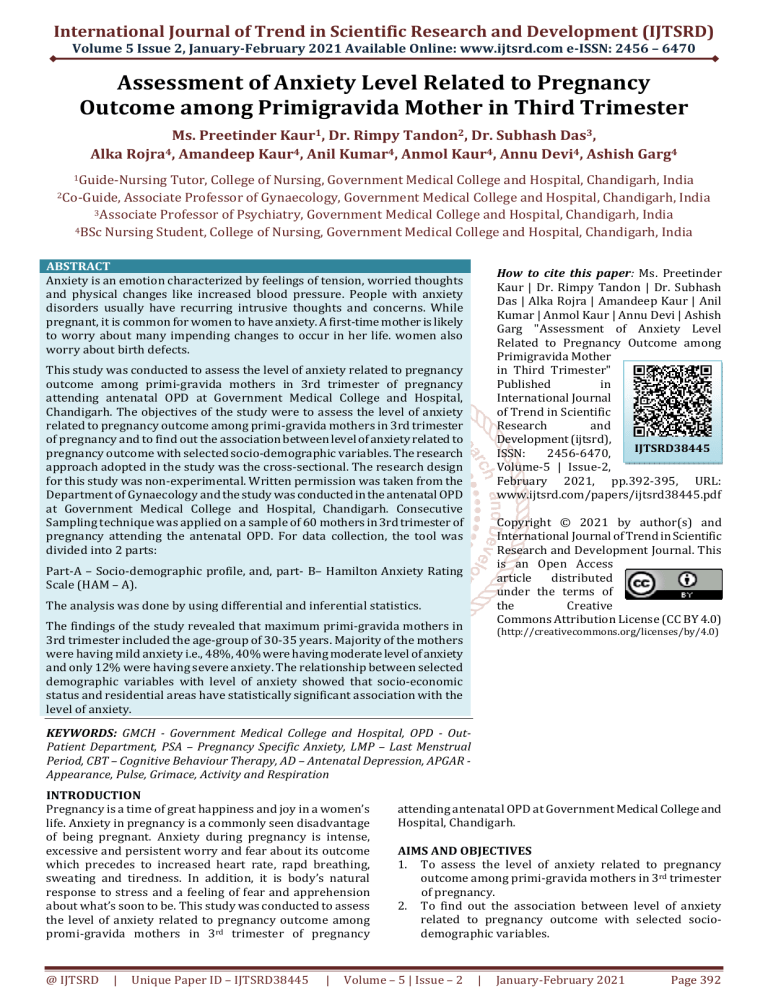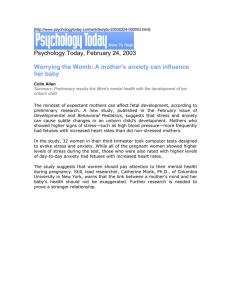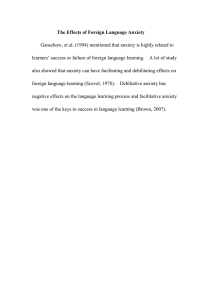
International Journal of Trend in Scientific Research and Development (IJTSRD)
Volume 5 Issue 2, January-February 2021 Available Online: www.ijtsrd.com e-ISSN: 2456 – 6470
Assessment of Anxiety Level Related to Pregnancy
Outcome among Primigravida Mother in Third Trimester
Ms. Preetinder Kaur1, Dr. Rimpy Tandon2, Dr. Subhash Das3,
Alka Rojra4, Amandeep Kaur4, Anil Kumar4, Anmol Kaur4, Annu Devi4, Ashish Garg4
1Guide-Nursing
Tutor, College of Nursing, Government Medical College and Hospital, Chandigarh, India
Associate Professor of Gynaecology, Government Medical College and Hospital, Chandigarh, India
3Associate Professor of Psychiatry, Government Medical College and Hospital, Chandigarh, India
4BSc Nursing Student, College of Nursing, Government Medical College and Hospital, Chandigarh, India
2Co-Guide,
ABSTRACT
Anxiety is an emotion characterized by feelings of tension, worried thoughts
and physical changes like increased blood pressure. People with anxiety
disorders usually have recurring intrusive thoughts and concerns. While
pregnant, it is common for women to have anxiety. A first-time mother is likely
to worry about many impending changes to occur in her life. women also
worry about birth defects.
How to cite this paper: Ms. Preetinder
Kaur | Dr. Rimpy Tandon | Dr. Subhash
Das | Alka Rojra | Amandeep Kaur | Anil
Kumar | Anmol Kaur | Annu Devi | Ashish
Garg "Assessment of Anxiety Level
Related to Pregnancy Outcome among
Primigravida Mother
in Third Trimester"
Published
in
International Journal
of Trend in Scientific
Research
and
Development (ijtsrd),
IJTSRD38445
ISSN:
2456-6470,
Volume-5 | Issue-2,
February 2021, pp.392-395, URL:
www.ijtsrd.com/papers/ijtsrd38445.pdf
This study was conducted to assess the level of anxiety related to pregnancy
outcome among primi-gravida mothers in 3rd trimester of pregnancy
attending antenatal OPD at Government Medical College and Hospital,
Chandigarh. The objectives of the study were to assess the level of anxiety
related to pregnancy outcome among primi-gravida mothers in 3rd trimester
of pregnancy and to find out the association between level of anxiety related to
pregnancy outcome with selected socio-demographic variables. The research
approach adopted in the study was the cross-sectional. The research design
for this study was non-experimental. Written permission was taken from the
Department of Gynaecology and the study was conducted in the antenatal OPD
at Government Medical College and Hospital, Chandigarh. Consecutive
Sampling technique was applied on a sample of 60 mothers in 3rd trimester of
pregnancy attending the antenatal OPD. For data collection, the tool was
divided into 2 parts:
Copyright © 2021 by author(s) and
International Journal of Trend in Scientific
Research and Development Journal. This
is an Open Access
article
distributed
under the terms of
the
Creative
Commons Attribution License (CC BY 4.0)
Part-A – Socio-demographic profile, and, part- B– Hamilton Anxiety Rating
Scale (HAM – A).
The analysis was done by using differential and inferential statistics.
The findings of the study revealed that maximum primi-gravida mothers in
3rd trimester included the age-group of 30-35 years. Majority of the mothers
were having mild anxiety i.e., 48%, 40% were having moderate level of anxiety
and only 12% were having severe anxiety. The relationship between selected
demographic variables with level of anxiety showed that socio-economic
status and residential areas have statistically significant association with the
level of anxiety.
(http://creativecommons.org/licenses/by/4.0)
KEYWORDS: GMCH - Government Medical College and Hospital, OPD - OutPatient Department, PSA – Pregnancy Specific Anxiety, LMP – Last Menstrual
Period, CBT – Cognitive Behaviour Therapy, AD – Antenatal Depression, APGAR Appearance, Pulse, Grimace, Activity and Respiration
INTRODUCTION
Pregnancy is a time of great happiness and joy in a women’s
life. Anxiety in pregnancy is a commonly seen disadvantage
of being pregnant. Anxiety during pregnancy is intense,
excessive and persistent worry and fear about its outcome
which precedes to increased heart rate, rapd breathing,
sweating and tiredness. In addition, it is body’s natural
response to stress and a feeling of fear and apprehension
about what’s soon to be. This study was conducted to assess
the level of anxiety related to pregnancy outcome among
promi-gravida mothers in 3rd trimester of pregnancy
@ IJTSRD
|
Unique Paper ID – IJTSRD38445
|
attending antenatal OPD at Government Medical College and
Hospital, Chandigarh.
AIMS AND OBJECTIVES
1. To assess the level of anxiety related to pregnancy
outcome among primi-gravida mothers in 3rd trimester
of pregnancy.
2. To find out the association between level of anxiety
related to pregnancy outcome with selected sociodemographic variables.
Volume – 5 | Issue – 2
|
January-February 2021
Page 392
International Journal of Trend in Scientific Research and Development (IJTSRD) @ www.ijtsrd.com eISSN: 2456-6470
ASSUMPTION
We assume that primi-gravida mothers in 3rd trimester of
pregnancy, will have anxiety related to pregnancy outcome.
METHODOLOGY
Research approach- The research approach adopted in
the study was cross-sectional research approach.
Research Design-The research design for this study
was non-experimental study to assess the level of
anxiety
Research setting- The research was conducted at the
antenatal OPD at Gmch-32, Chd
Target population- Target population for this study
was primigravida mothers in 3rd trimester of pregnancy
attending antenatal OPD at Gmch-32, Chd.
Sampling techniques- Consecutive sampling technique
was adopted for data collection Sample size- The
sample size of study was 60 primigravida mothers in 3rd
trimester of pregnancy.
1.
2.
3.
4.
5.
Inclusion criteria
Primi-gravida mothers in their 3rd trimester.
Women willing to participate, and had given consent for
the same.
Women who can read and/or understand English, Hindi
or Punjabi languages.
Women attending antenatal OPD at Government Medical
College and Hospital, Chandigarh.
Women who are conscious and are able to follow verbal
instructions.
Analysis of the data was done in accordance with the
objectives of the study.
FINDINGS
SECTION-A ASSESSMENT OF LEVEL OF ANXIETY
RELATED TO PREGNANCY OUTCOME
TABLE NO 1 this section deals with the level of anxiety
related to pregnancy outcome. Subjects studied were
60 primi-gravida mothers, who were in 3rd trimester
of pregnancy (N=60)
LEVEL OF
FREQUENCY PERCENTAGE
RANGE
ANXIETY
(n)
(%)
MILD
<17
29
48
MODERATE 18-24
24
40
SEVERE
25-30
7
12
The table 1 revealed that 29 primi-gravida mothers had mild
level of anxiety, 24 primi-gravida mothers had moderate
level of anxiety and 7 primi-gravida mothers had severe level
of anxiety. Hence, interpretation was that 48% study
subjects had mild level of anxiety, 40% study subjects had
moderate level of anxiety and 12% had severe level of
anxiety.
Exclusion criteria1. Intellectually challenged or subjects with mental illness.
2. Women in their 1st or 2nd trimester.
3. Pregnant women having medical and/or obstetric
complications
Tool of data collection- The tool was divided into 2 parts:
Part A: Socio-demographic ProfilePart B: Hamilton Anxiety
Rating Scale (to assess the level of anxiety related to
pregnancy outcome among primi-gravida mothers in 3rd
trimester of pregnancy attending antenatal OPD at
Government Medical College and Hospital, Chandigarh.)
Method of data collection- The data was collected through
interview method
Analysis and Interpretation- Data analysis was done using
Descriptive and Inferential statistics. Responses were
analyzed in term of total score gained by the subject.
Figure 1: Percentage distribution of study subjects as
per level of anxiety related to pregnancy outcome
among primi-gravida mothers in 3rd trimester of
pregnancy attending antenatal OPD at Government
Medical Collegeand Hospital, Chandigarh
SECTION-B ASSOCIATION BETWEEN LEVEL OF ANXIETY RELATED TO PREGNANCY OUTCOME WITH SOCIODEMOGRAPHIC VARIABLES
RESIDENCE
VARIABLE
Urban
Rural
FREQUENCY (n)
35
25
TABLE NO. 1
PERCENTAGE (%)
58.3
41.7
CHI-SQUARE VALUE
df
REMARKS
71.874
p=0.002
6
Statistically significant
TABLE 1. Depicts the association between residence and level of anxiety related to pregnancy outcome. The value of chi-square
is 71.874 and df value is 6. It is concluded that residence has high statistical significance with level of anxiety at p<0.05.
@ IJTSRD
|
Unique Paper ID – IJTSRD38445
|
Volume – 5 | Issue – 2
|
January-February 2021
Page 393
International Journal of Trend in Scientific Research and Development (IJTSRD) @ www.ijtsrd.com eISSN: 2456-6470
VARIABLE
Upper class
Upper middle
SOCIOECONOMIC Lower middle
STATUS
Upper lower
Lower class
FREQUENCY (n)
0
19
38
2
1
TABLE NO. 2
PERCENTAGE (%)
0
31.7
63.3
3.3
1.7
CHI- SQUARE VALUE
df
REMARKS
72.803
p=0.026
12
Statistically
significant
TABLE 2. Depicts the association between socio-economic status and level of anxiety related to pregnancy outcome. The value
of chi-square is 72.803 and df value is 12. It is concluded that socio-economic status has high statistical significance with level
of anxiety at p<0.05.
CONCLUSION
The present study was conducted on 60 primigravida
mothers in 3rd trimester of pregnancy attending antenatal
OPD at Government Medical College and Hospital,
Chandigarh, to assess the level of anxiety related to
pregnancy outcomes among primigravida mothers in 3rd
trimester of pregnancy. The findings of the study revealed
that maximum primigravida mothers in 3rd trimester
included age group of 30-35 years. Majority of the mothers
were having mild anxiety i.e., 48%, 40% were having
moderate level of anxiety and only 12% were having severe
anxiety. The relationship between selected demographic
variables with level of anxiety showed that socioeconomic
status and residential areas have statistically significant
association with the level of anxiety.
DISCUSSION
This result could not be generalized due to small sample size
and clinical setting of data collection. But based on the
findings future studies can be done on large sample size by
using comparative and/or exploratory research design.
REFERENCES
[1] Pregnancy. In: Wikipedia [Internet]. 2020 [cited 2020
Jul 6]. Available from:
https://en.wikipedia.org/w/index.php?title=Pregnan
cy&oldid=965315025
[2]
What are some factors that make a pregnancy high
risk?
[Internet].
https://www.nichd.nih.gov/.
[cited
2020
Jul
6].
Available
from:
https://www.nichd.nih.gov/health/topics/highrisk/conditioninfo/factors
[3]
Anxiety During Pregnancy | Lifespan Multidisciplinary
Obstetric Medicine Service (MOMS) [Internet]. [cited
2020 Jul 6]. Available from: https://www. lifespan.
org/centers-services/multidisciplinary-obstetricmedicine-service-moms/common-conditionsduring/anxiety
[4]
Priyambada K, Pattojoshi A, Bakhla AK. A study of
antenatal anxiety: comparison across trimesters. Int J
Reprod Contracept Obstet Gynecol. 2017 Apr 27;
6(5):1810–3.
[5]
Silva MM de J, Nogueira DA, Clapis MJ, Leite EPRC.
Anxiety in pregnancy: prevalence and associated
factors. Rev Esc Enferm USP. 2017; 51.
[6]
Walia N, Ramanadin PV. A Descriptive Study to Assess
the Level of Anxiety Related to Labour Process among
Primigravida in Selected Hospitals of Punjab and
Haryana. Int J Nurs Educ Res. 2013 Dec 28; 1(1):22–5.
@ IJTSRD
|
Unique Paper ID – IJTSRD38445
|
[7]
Johnson AR, Kumar MG, Jacob R, Jessie MA, Mary F,
Agrawal T, et al. Fear of Childbirth among Pregnant
Women Availing Antenatal Services in a Maternity
Hospital in Rural Karnataka. Indian J Psychol Med.
2019 Aug; 41(4):318–22.
[8]
S S, Kd P. Anxiety on Primigravid Women Attending
Antenatal Care: A Hospital Based Cross-sectional
Study. Kathmandu Univ Med J KUMJ. 2018 Jan 1;
16(61):23–7.
[9]
Soto-Balbuena C, Rodríguez MF, Escudero Gomis AI,
Ferrer Barriendos FJ, Le H-N, Pmb-Huca G. Incidence,
prevalence and risk factors related to anxiety
symptoms during pregnancy. Psicothema. 2018 Aug;
30(3):257–63.
[10]
Madhavanprabhakaran GK, D’Souza MS, Nairy KS.
Prevalence of pregnancy anxiety and associated
factors. Int J AfrNurs Sci. 2015 Jan 1; 3:1–7.
[11]
Bhavya SV, Parvathi NK, Bhagyalakshmi HS, Kumar S,
Munirathnamma. A Study on Awareness and Anxiety
Level of Primigravida Mothers on Labour and its
Outcome in a Selected Hospital, Mysore. Int J Nurs
Educ. 2015; 7(1):184.
[12]
Effectiveness of pre delivery preparation on anxiety
among Primigravida mothers at maternal child health
centre Tirupati, AP, India - [PDF Document]
[Internet]. vdocuments. site. [cited 2020 Jul 6].
Available
from:
https://vdocuments.site/effectiveness-of-predelivery-preparation-on-anxiety-amongprimigravida-mothers. html
[13]
Shalhosseini Z, Pourasghar M, Khalilian A, salehi F.
Effects of anxiety during pregnancy on children,s
health. Mater Socio med. 2015; 27(3):200-2.
[14]
Latheef AJKM and F. A study to assess the level of
anxiety related to childbirth among primi antenatal
women in selected hospitals, Bangalore. Int J Pharma
Bio Sci [Internet]. 2017 Jun [cited 2020 Jul 6]; Volume
8
Issue
2.
Available
from:
http://ijpbs.net/abstract.php?article=5838
[15]
Devi NS, Shinde P, Shaikh G, Khole S. Level of anxiety
towards childbirth among primigravida and
multigravida mothers. Int J Appl Res. 2018 May 1;
4(5):221–4.
[16]
Kingma N. Maternal anxiety and the mother – child
relationship. Univ Vas Tilburg. 2014; 6(4):182-86.
[17]
Faisal-Cury A, Rossi Menezes P. Prevalence of anxiety
and depression during pregnancy in a private setting
Volume – 5 | Issue – 2
|
January-February 2021
Page 394
International Journal of Trend in Scientific Research and Development (IJTSRD) @ www.ijtsrd.com eISSN: 2456-6470
sample. Arch WomensMent Health. 2007 Feb;
10(1):25–32.
[18]
C S. Study to assess the anxiety related to onset of
labor and delivery among primigravida mothers
admitted for delivery at vanivilas hospital bangalore
[Internet] [Thesis]. RGUHS; 2007 [cited 2020 Jul 6].
Available
from:
http://localhost:8080/xmlui/handle/123456789/13
12
[19]
Nekoee T, Zarei M, Shen C. Evaluation the Anxiety
Status of Pregnant Women in the Third Trimester of
Pregnancy and Fear of Childbirth and Related Factors.
Br J Med Med Res. 2015 Jan 10; 9:1–8.
[20]
Sapkota B, Mali NS, Singh RD. Prenatal Anxiety among
Pregnant Women Visiting in Antenatal Care
Outpatient Department at Paropakar Maternity and
Women’s Hospital. Int J Health Sci Res. 2019;
9(3):173–81.
@ IJTSRD
|
Unique Paper ID – IJTSRD38445
|
[21]
Shahhosseini Z, Pourasghar M, Khalilian A, Salehi F. A
Review of the Effects of Anxiety during Pregnancy on
Children's Health. Materia Socio Medica. 2015;
27(3):200-2.
[22]
Thomas CZ, A S, A S, Puthur KJ, Kiran P, T S. Screening
for Anxiety among Antenatal Women Attending a
Taluk Hospital in Rural India -. Natl J Community Med.
2015; 6(3):313– 7.
[23]
Biaggi A, Conroy S, Pawlby S, Pariante CM. Identifying
the women at risk of antenatal anxiety and
depression: A systematic review. J Affect Disord. 2016
Feb 1; 191:62–77.
[24]
Nath A, Venkatesh S, Balan S, Metgud CS, Krishna M,
Murthy GVS. The prevalence and determinants of
pregnancy-related anxiety amongst pregnant women
at less than 24 weeks of pregnancy in Bangalore,
Southern India. Int J Womens Health. 2019; 11:241–8.
Volume – 5 | Issue – 2
|
January-February 2021
Page 395



